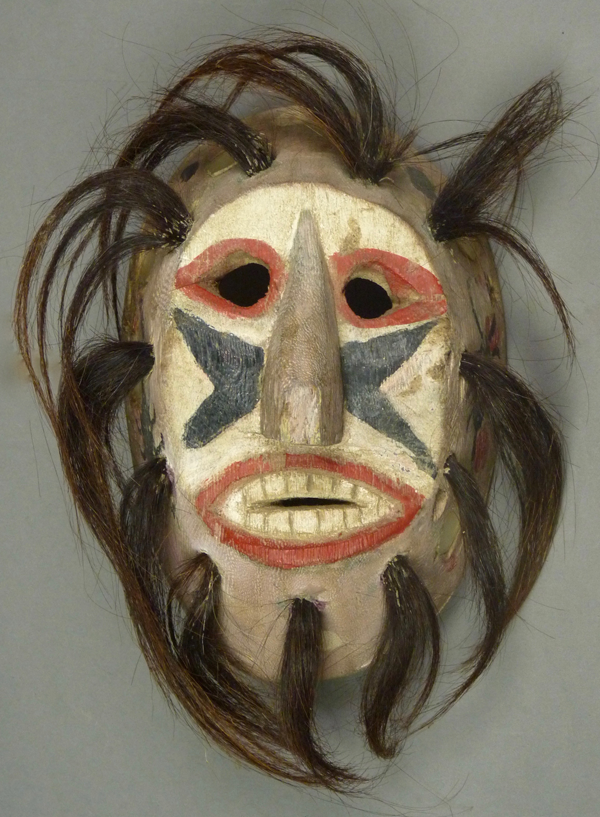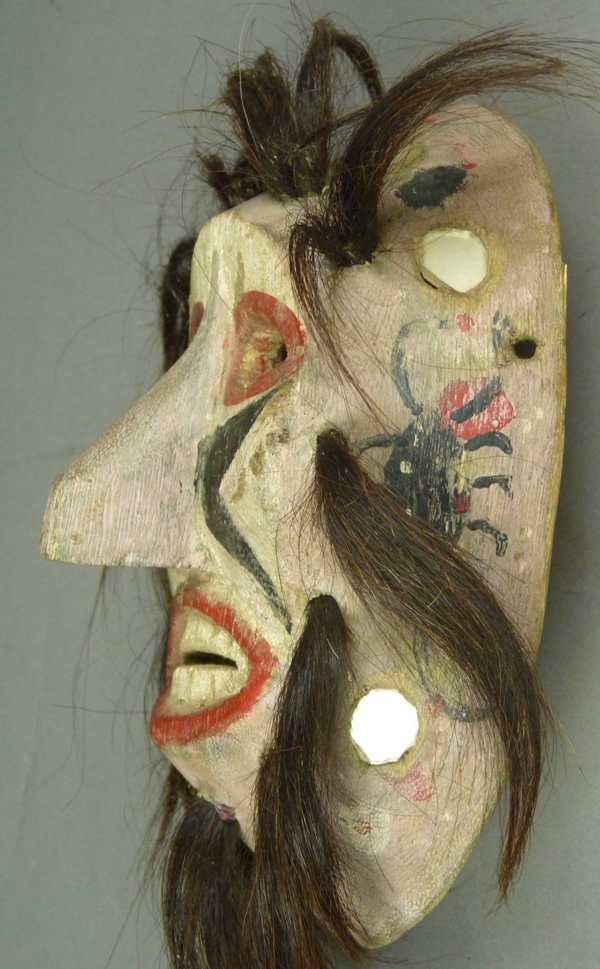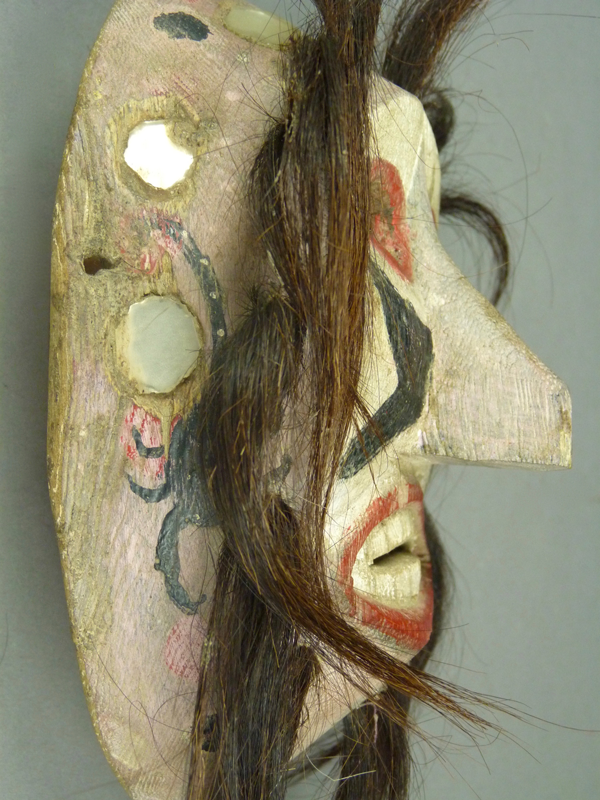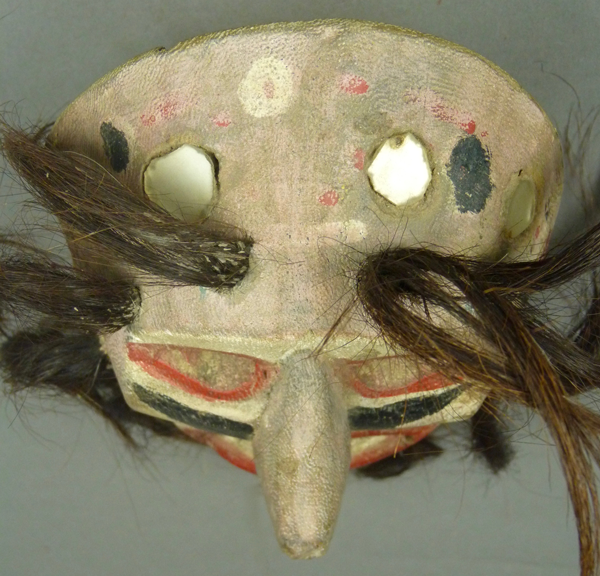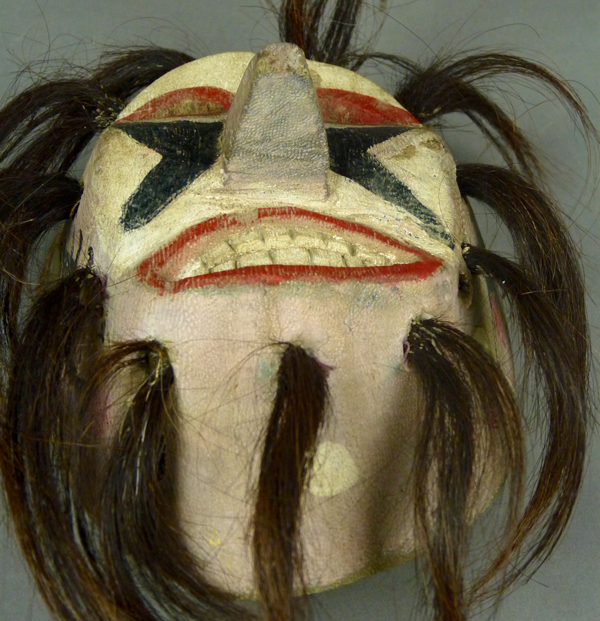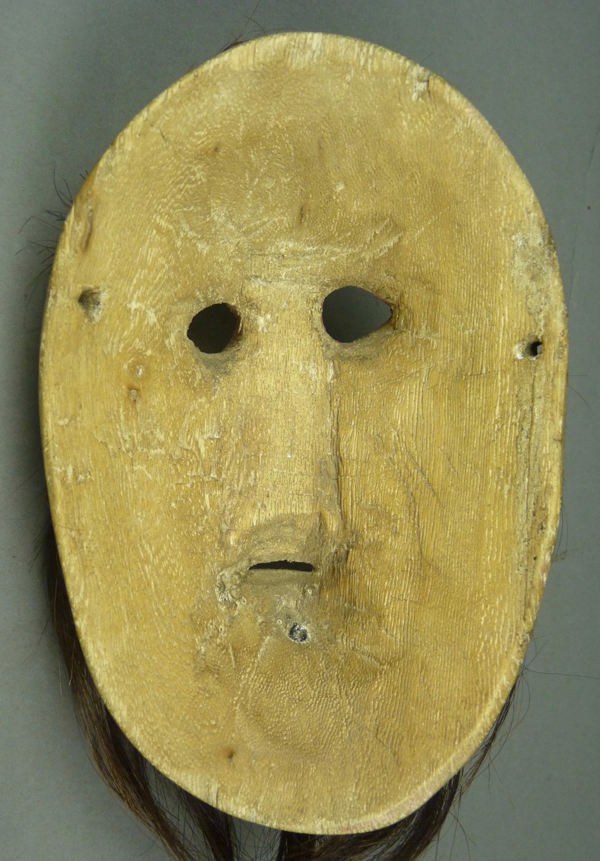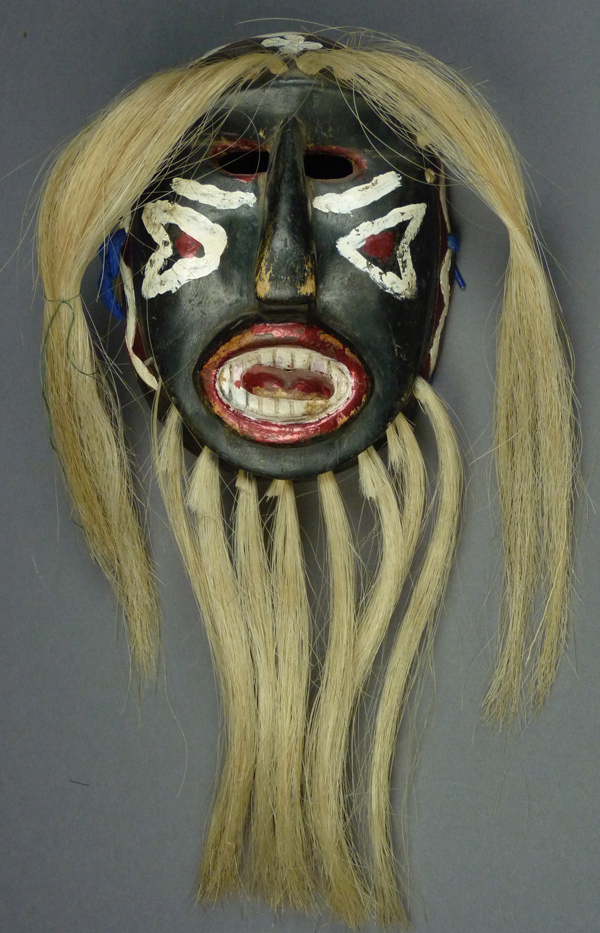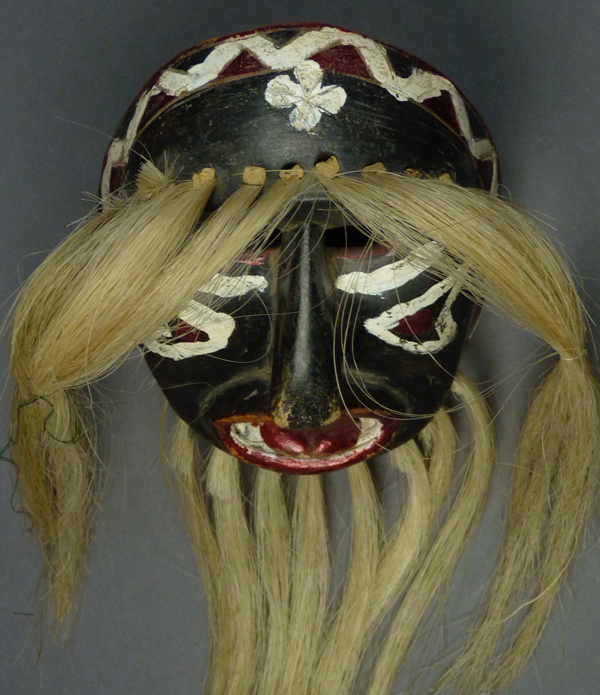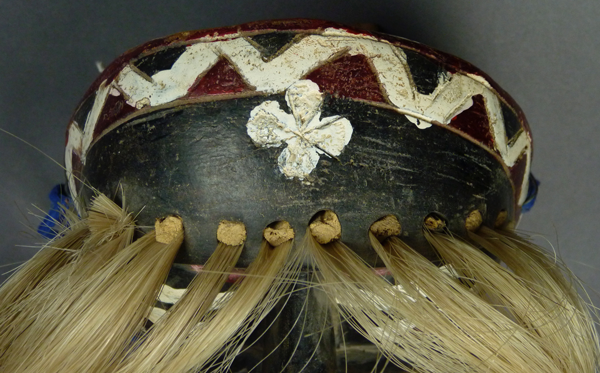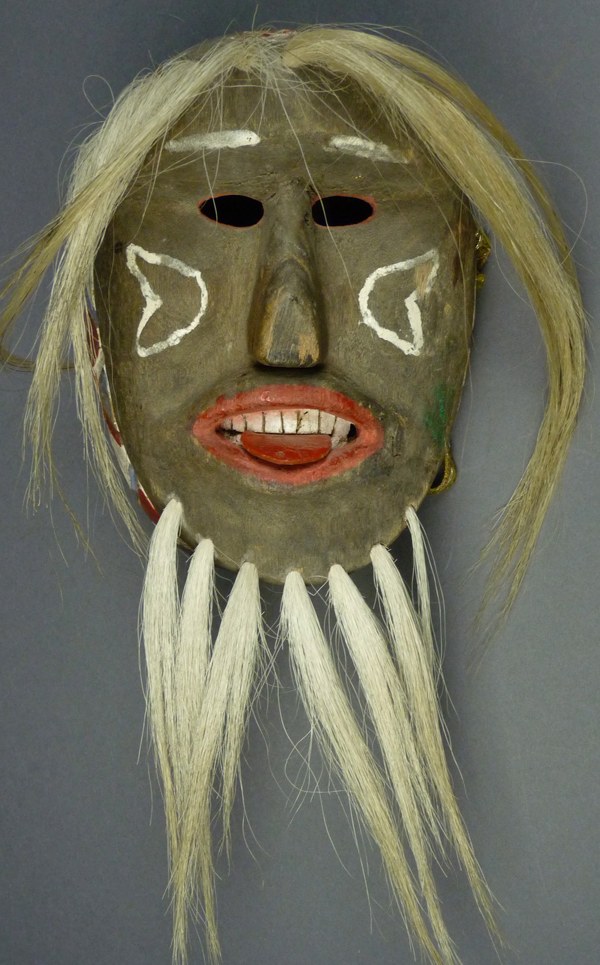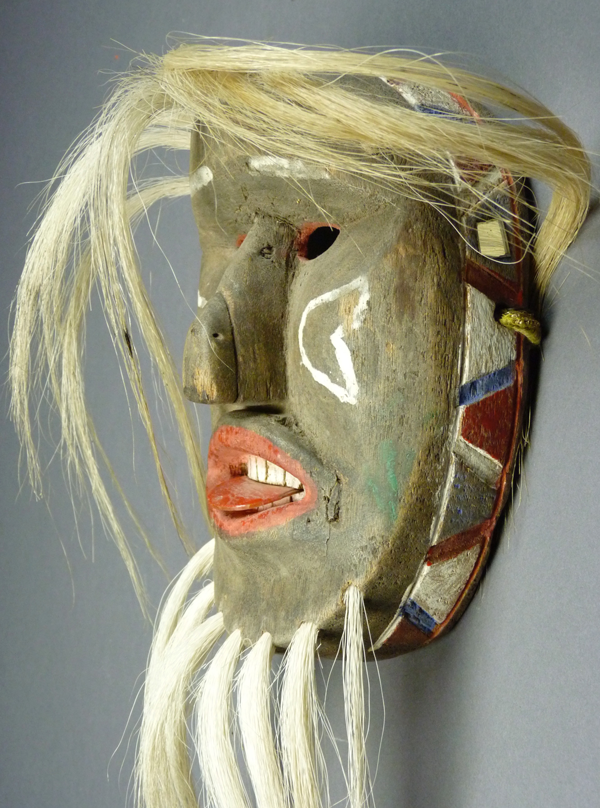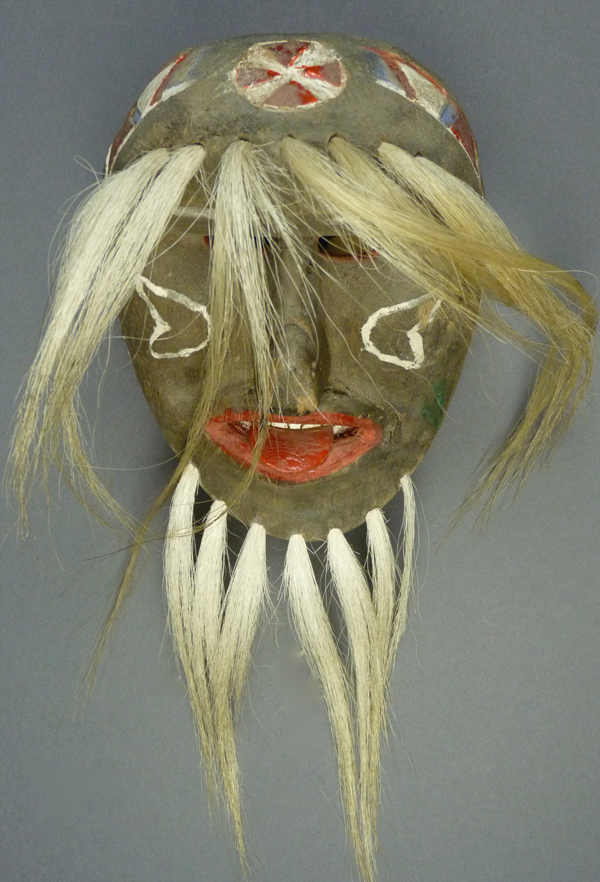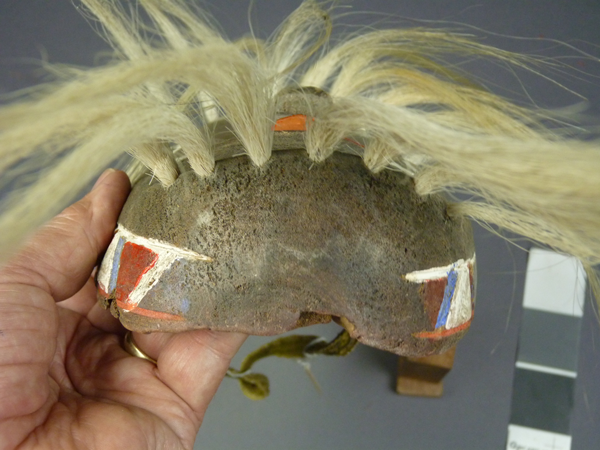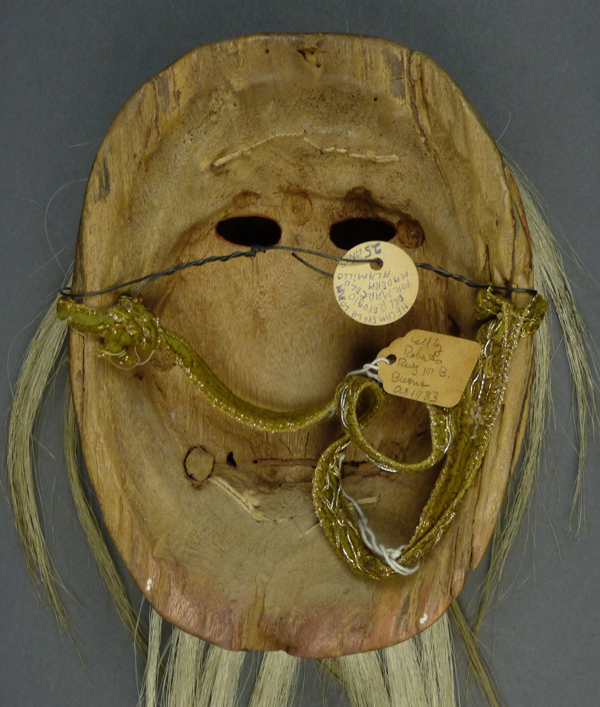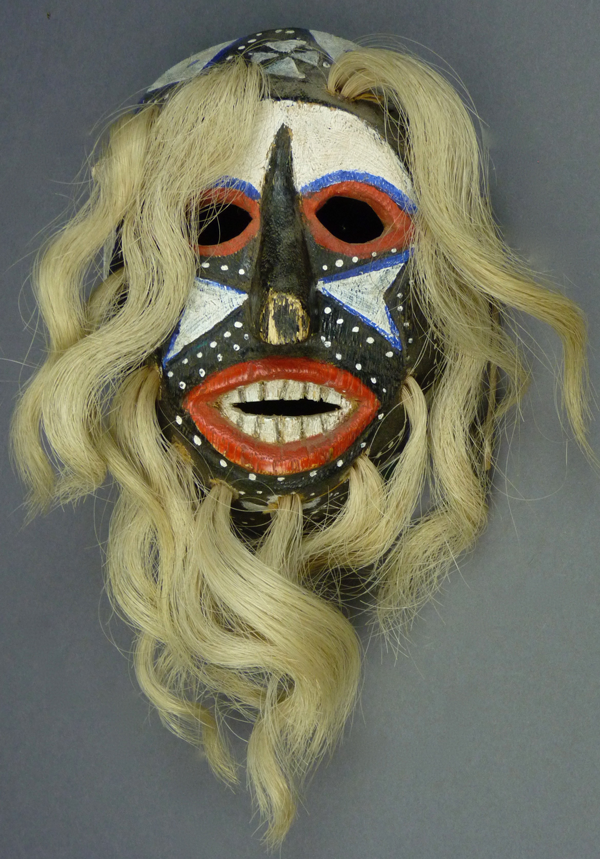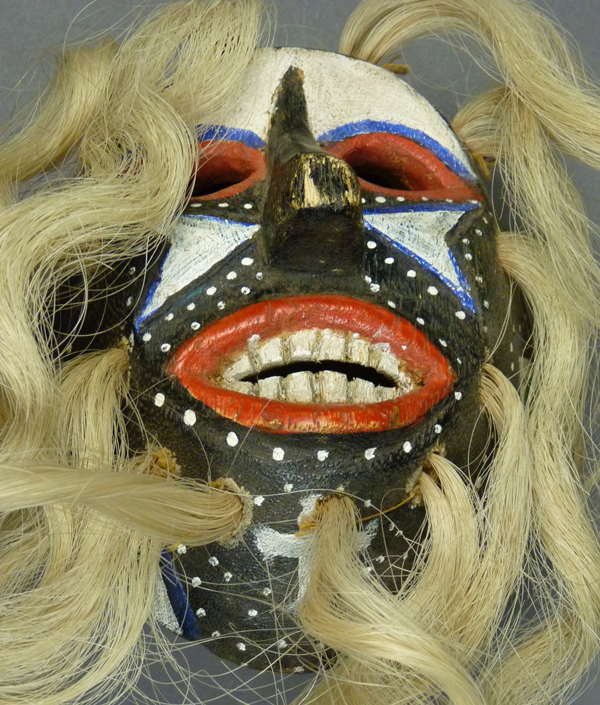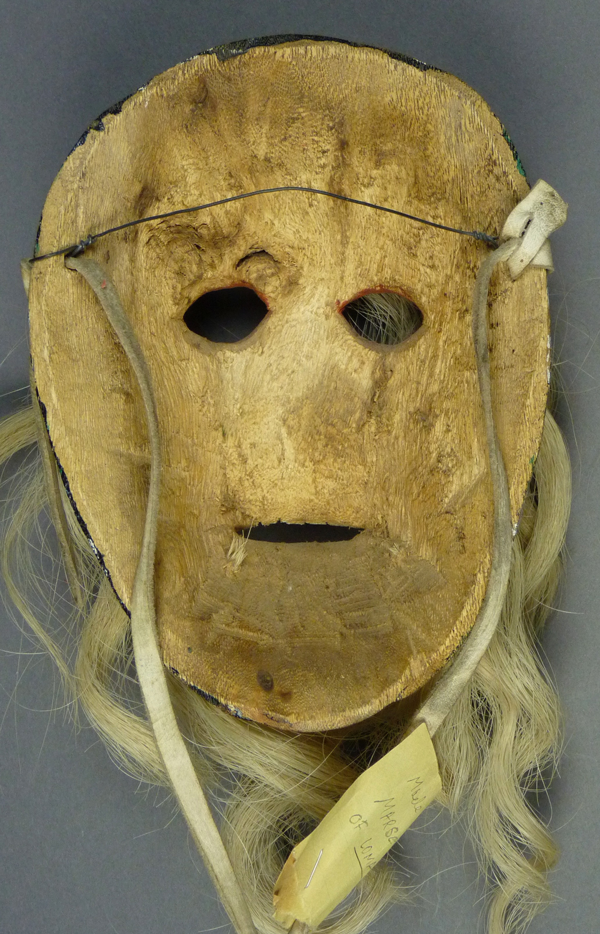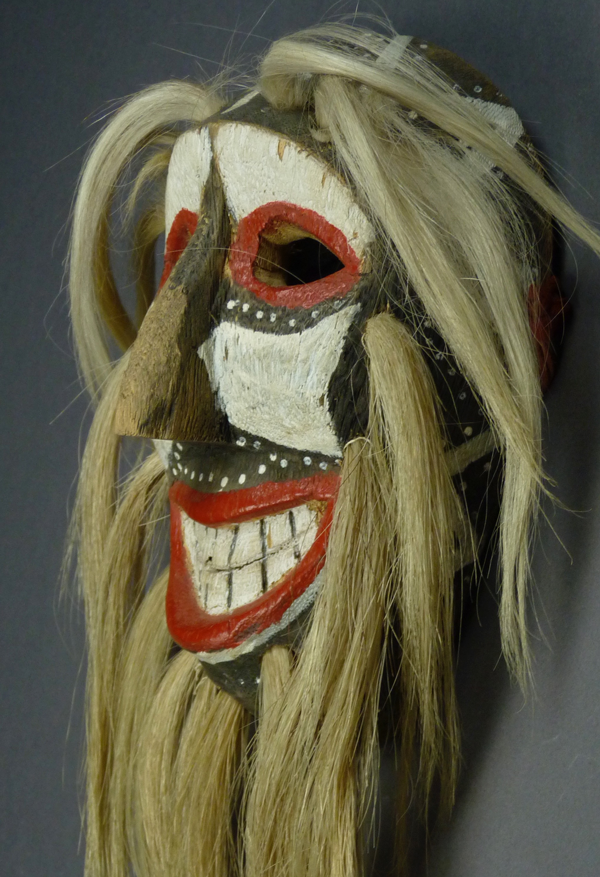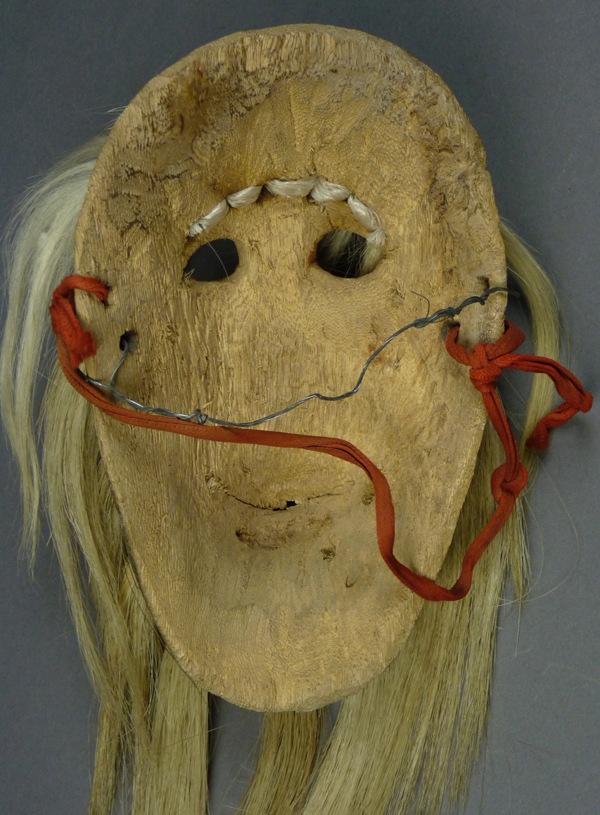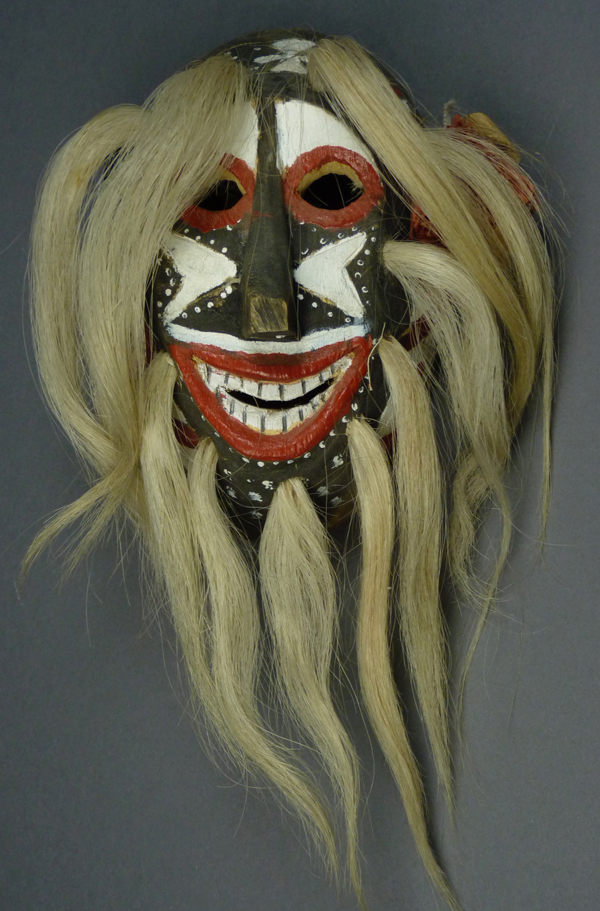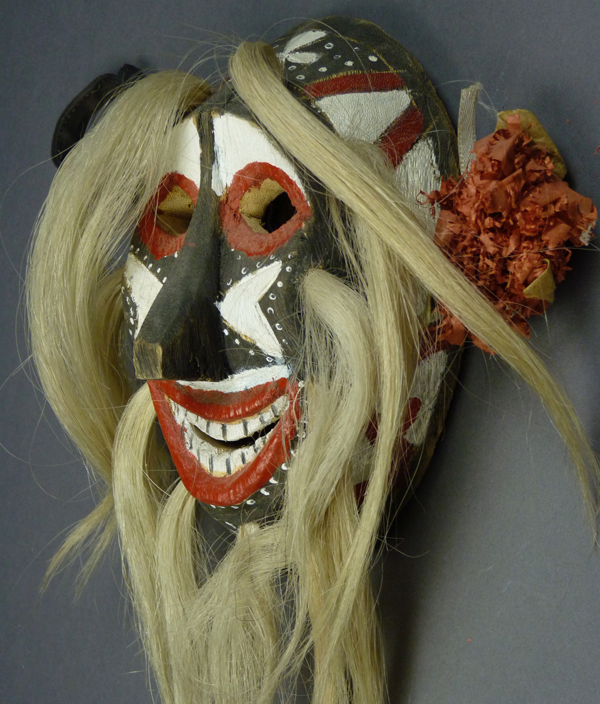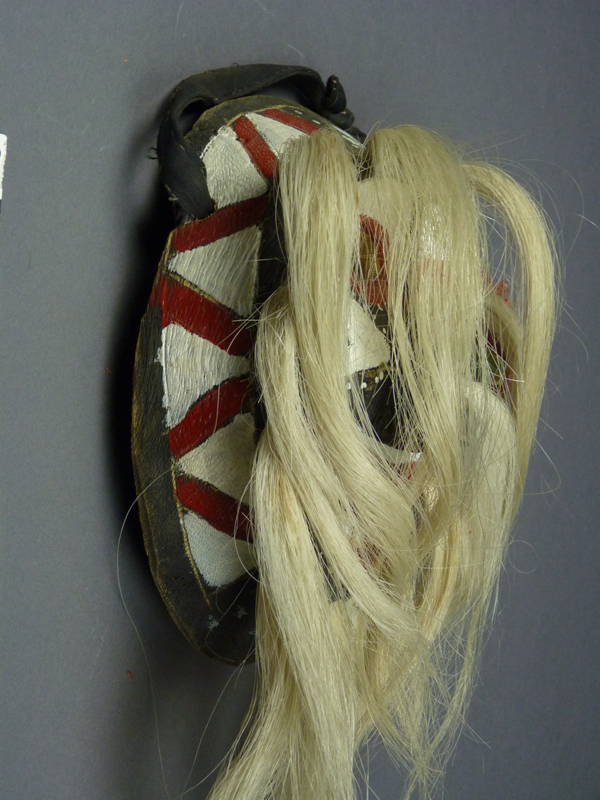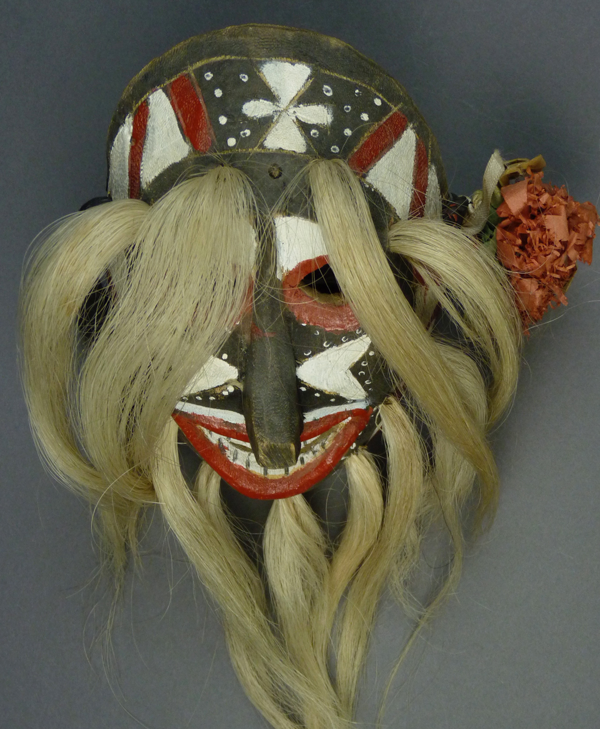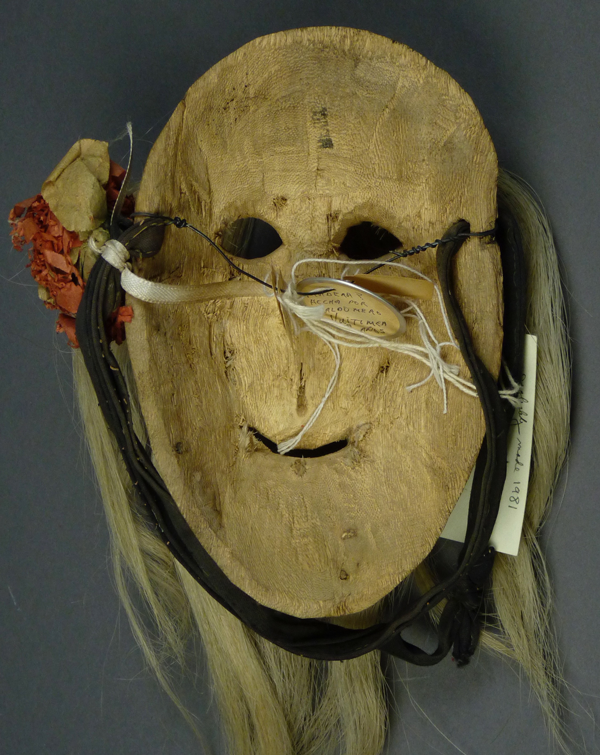Last week we looked at masks that were probably carved by Plácido Alamea, rather than by his son Marcelo Alamea. This week I will show masks that were identified at the time of collection as the work of his son. It is possible that some of these were carved by Plácido. I bought the first of today’s masks on EBay™ in 2010 as an anonymous mask. Comparing it with masks by Plácido and Marcelo in other collections, it seemed much more likely to be by the latter. My general impression is that the noses on Marcelo’s masks imitate those of his father, but they are often less delicately carved.
The profile of this nose is typical of masks by the Alameas. The cheeks are convex. In lieu of a formal rim design, there are hand shaped circular mirrors irregularly spaced around the rim, and painted scorpions on both sides.
The nose has a blunted end.
There is a painted cross on the forehead, which is worn and not easy to see. Holding this mask in my hands, I find wooden pegs holding the bundles of hair in place.
The chevron shapes on the cheeks are somewhat carelessly drawn. There is a circle of hair around the face.
This mask is 7 inches tall, 4½ inches wide, and 3 inches deep.
The back is moderately stained from significant use. The hair bundles are not held by string.
I photographed the rest of the masks in today’s post when they were in the collection of Jerry Collings, in 2011, and he kindly gave me permission to publish them. I believe that they are no longer in his collection, and they may have been traded to Gallery West in Tucson, Arizona.
The first of these was collected by Roberto Ruiz for Barney Burns in 1983, and it was said to have been danced for 30 years. So it was estimated to date from about 1953. It is a handsome mask, but sloppy repainting obscures this.
There is a tapered nose, broad at the lower end and progressively narrow as it rises to meet the forehead. The mask was carefully carved and there are convex cheeks. There is not a circle of hair around the face.
The forehead cross and the rim design have both been crudely repainted, but they appear to have been carefully carved.
The details of the original carving are better seen in this closer view, which reveals a traditional Alamea style rim design Also note that the hair bundles are secured by wooden pegs, another Alamea characteristic.
This mask is 7 inches tall, 5¼ inches wide, and 3 inches deep.
The back of this mask is heavily stained from use. Note that the hair was pegged and also stitched in place.
The next mask, which was also collected by Roberto Ruiz in 1983, was said to have been danced for 25 years (made circa 1958). Its design looks similar to the one above.
The blunt tip of the nose had broken off and been reattached or repaired. The cheeks have a convex shape. There is a traditional Alamea style rim design, and this has not been obscured by sloppy repainting. Visible in this side view is an inlaid mirror square within the rim design, reminding us of the inlaid brass squares on one of last week’s masks.
These hair bundles don’t appear to have been secured by wooden pegs, and there was never a circle of hair around the face.. There is an attractive carved cross on the forehead.
The rim design is not continuous under the chin and there is no evidence of a chin cross.
This mask is 7½ inches tall, 5½ inches wide, and 2½ inches deep.
The back appears to be worn from use, but also dusty. The hair bundles are tied in place as usual.
The next mask was said to date to circa 1960, and it too was collected in the 1980’s.
The nose on this mask has a more pronounced taper than the three masks above. As usual it has a blunted end. There is a circle of hair around the face.
The rims of these eyes were carved in relief.
The rim design, chrevons on the cheeks, and forehead cross were all painted but not carved. in outline.
There is also a painted chin cross. This mask is 7¼ inches tall, 5½ inches wide, and 3 inches deep.
The hair bundles are not tied in the back, so evidently they are held in place by wooden pegs, but the photos fail to reveal those pegs. This mask has only moderate staining from use.
This mask was said to date to 1975.
The rings around the eyes are painted but not carved in relief. The nose tapers to a point but lacks the long skinny upper section that we find on some Alamea masks. The rim design and forehead cross are painted rather than carved. There is no chin cross.
The nose has a nice shape in the side view. There is a circle of hair around the face.
I don’t see pegs in the photos. This mask is 7 7/8 inches tall, 4¾ inches wide, and 3¼ inches deep.
The hair bundles across the forehead are tied in place, and evidently the rest are held only by wooden pegs. The back is moderately stained from use.
The last of these masks was collected in about 1981 by Barney Burns after just 2 years of use.
There is a classic Alamea style nose, tapered to a narrow strip at the top and blunt at the end. The chevrons on the cheeks appear to have carved outlines. There is a circle of hair around the face.
The mask was accompanied by the paper “sewa” (flower) worn by the Pascola dancer in his topknot of hair when the mask was last danced.
Both the rim design and the forehead cross were originally outlined by inscribed lines. There is a wooden peg visible in a hole under the forehead cross where the hair has been lost.
This mask is 7½ inches tall, 5 inches wide, and 3 inches deep.
All of the hair bundles seem to have been held with wooden pegs, as there is no string on the back of the mask to anchor the bundles. Staining from use is mild.
I hope that you have enjoyed seeing Marcelo Alamea’s masks, to compare them to those of his father, Plácido Alamea. Next week we will examine the masks of another Rio Mayo master, Brígido Valenzuela.
Bryan Stevens

